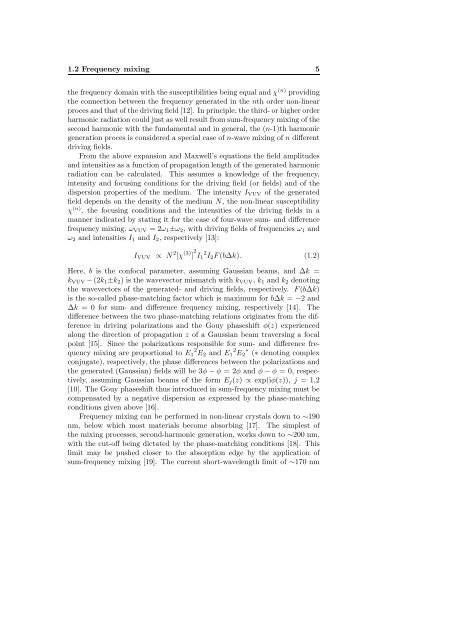VUV Spectroscopy of Atoms, Molecules and Surfaces
VUV Spectroscopy of Atoms, Molecules and Surfaces
VUV Spectroscopy of Atoms, Molecules and Surfaces
Create successful ePaper yourself
Turn your PDF publications into a flip-book with our unique Google optimized e-Paper software.
1.2 Frequency mixing 5<br />
the frequency domain with the susceptibilities being equal <strong>and</strong> χ (n) providing<br />
the connection between the frequency generated in the nth order non-linear<br />
proces <strong>and</strong> that <strong>of</strong> the driving field [12]. In principle, the third- or higher order<br />
harmonic radiation could just as well result from sum-frequency mixing <strong>of</strong> the<br />
second harmonic with the fundamental <strong>and</strong> in general, the (n-1)th harmonic<br />
generation proces is considered a special case <strong>of</strong> n-wave mixing <strong>of</strong> n different<br />
driving fields.<br />
From the above expansion <strong>and</strong> Maxwell’s equations the field amplitudes<br />
<strong>and</strong> intensities as a function <strong>of</strong> propagation length <strong>of</strong> the generated harmonic<br />
radiation can be calculated. This assumes a knowledge <strong>of</strong> the frequency,<br />
intensity <strong>and</strong> focusing conditions for the driving field (or fields) <strong>and</strong> <strong>of</strong> the<br />
dispersion properties <strong>of</strong> the medium. The intensity I<strong>VUV</strong> <strong>of</strong> the generated<br />
field depends on the density <strong>of</strong> the medium N, the non-linear susceptibility<br />
χ (n) , the focusing conditions <strong>and</strong> the intensities <strong>of</strong> the driving fields in a<br />
manner indicated by stating it for the case <strong>of</strong> four-wave sum- <strong>and</strong> difference<br />
frequency mixing, ω<strong>VUV</strong> =2ω1±ω2, with driving fields <strong>of</strong> frequencies ω1 <strong>and</strong><br />
ω2 <strong>and</strong> intensities I1 <strong>and</strong> I2, respectively [13]:<br />
I<strong>VUV</strong> ∝ N 2 [χ (3) ] 2 I1 2 I2F (b∆k). (1.2)<br />
Here, b is the confocal parameter, assuming Gaussian beams, <strong>and</strong> ∆k =<br />
k<strong>VUV</strong> − (2k1±k2) is the wavevector mismatch with k<strong>VUV</strong>, k1 <strong>and</strong> k2 denoting<br />
the wavevectors <strong>of</strong> the generated- <strong>and</strong> driving fields, respectively. F (b∆k)<br />
is the so-called phase-matching factor which is maximum for b∆k = −2 <strong>and</strong><br />
∆k = 0 for sum- <strong>and</strong> difference frequency mixing, respectively [14]. The<br />
difference between the two phase-matching relations originates from the difference<br />
in driving polarizations <strong>and</strong> the Gouy phaseshift φ(z) experienced<br />
along the direction <strong>of</strong> propagation z <strong>of</strong> a Gaussian beam traversing a focal<br />
point [15]. Since the polarizations responsible for sum- <strong>and</strong> difference frequency<br />
mixing are proportional to E1 2 E2 <strong>and</strong> E1 2 E2 ∗ (∗ denoting complex<br />
conjugate), respectively, the phase differences between the polarizations <strong>and</strong><br />
the generated (Gaussian) fields will be 3φ − φ =2φ <strong>and</strong> φ − φ = 0, respectively,<br />
assuming Gaussian beams <strong>of</strong> the form Ej(z) ∝ exp(iφ(z)), j =1,2<br />
[10]. The Gouy phaseshift thus introduced in sum-frequency mixing must be<br />
compensated by a negative dispersion as expressed by the phase-matching<br />
conditions given above [16].<br />
Frequency mixing can be performed in non-linear crystals down to ∼190<br />
nm, below which most materials become absorbing [17]. The simplest <strong>of</strong><br />
the mixing processes, second-harmonic generation, works down to ∼200 nm,<br />
with the cut-<strong>of</strong>f being dictated by the phase-matching conditions [18]. This<br />
limit may be pushed closer to the absorption edge by the application <strong>of</strong><br />
sum-frequency mixing [19]. The current short-wavelength limit <strong>of</strong> ∼170 nm















